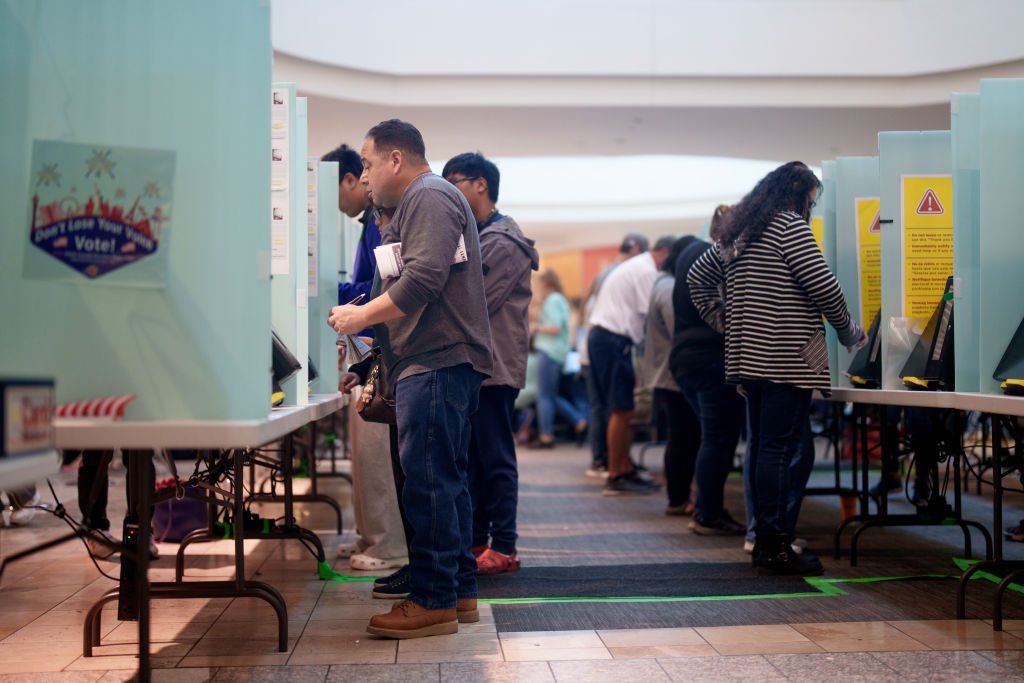
People vote at an early voting location in Henderson, Nevada, Friday, Nov. 1, 2024. (Eric Thayer for The Washington Post via Getty Images)
Nevada’s election results could take several days to report, but that’s because the vote counting and certification process is thorough and is meant to ensure every legal voter is able to cast their ballot, and that each of those ballots are verified. Here’s what to know about the vote counting process in Nevada, from beginning to end.
After every ballot is cast, Nevada’s system for counting up the votes stretches from the county level up to the Secretary of state, with multiple checks along the way.
“The thing about elections is they’re very decentralized,” Dan Lee, UNLV assistant professor of political science said. “So we have the presidential election, that’s the one national election, right? But even then, each state runs their elections slightly differently, and then even within a state, it’s administered at the county level.”
While different counties in Nevada may have additional rules or regulations for carrying out elections, ultimately the counties are governed by regulations laid out in Nevada state law.
Carrying out elections is handled by both local municipalities and counties. Cities assist with setting up polling places, but the counties appoint election board officers and handle counting of the votes, according to state statutes and representatives of Las Vegas, North Las Vegas, and the city of Henderson.
Here’s what to know about the vote counting process in Nevada, from beginning to end:
Vote counting process
About half of Nevada voters have cast ballots by mail in recent elections, and counting usually takes time.
But election offices are legally allowed to start processing and counting mail-in ballots 15 days before Election Day, according to state law. That means that since Oct. 21, counties have been able to process and count mail ballots as they’ve come in.
Processing ballots includes reviewing the voter’s signature on the return envelope to make sure it matches the one on file for them. If election officials identify an issue with the voter’s signature, they will also go through the signature cure process to contact voters to verify a ballot was really theirs.
Those results cannot be reported, however, until polls have closed on Election Day and every voter in line has voted and all polling locations in a county have closed.
As for ballots cast during in-person early voting, those can start to be counted when polls open at 8 a.m. on Election Day.
Once polls close at 7 p.m. on Election Day and the final voter in line has cast their ballot and every polling location has closed in a county, they can report their results. Reporting results before the final voter votes is illegal, so county-level vote counts can’t officially be reported by the Secretary of State website until then, according to state regulations.
Once all of the counties close their polls and begin counting, the Secretary of State’s Office will begin to post unofficial election night results online at silverstateelection.nv.gov, according to the website for the Secretary of State’s Office.
This process will take time, and it may take a few days for winners to be declared in close races.
What comes next?
After every county’s counting boards finish counting up the votes — which could take days, as mail ballots postmarked by Nov. 5 that arrive up to 4 days following Election Day can be counted — the votes then go to each county’s board of commissioners for canvassing, according to state law.
Canvassing means that the county commissioners check the poll results for clerical errors and remove any potentially illegitimate votes that result from errors, in an effort to make sure “that the result declared represents the true vote cast,” according to Nevada state statute.
State regulations mandate that all counties in Nevada must finish their canvass of election results within 10 days after the election.
After the canvass, each County must create an abstract that summarizes the results of the election. The County Clerk needs to certify the results in the abstract and send them to the Secretary of State.
The Secretary of State then meets with the Nevada Supreme Court on the fourth Tuesday of November to canvass the votes.
Then the Secretary of State certifies the results and the governor issues proclamations declaring the winners of Nevada’s elections, officially ending the elections for the year.
State law mandates that Nevada’s six presidential electors then vote for the presidential candidate who received the most votes in the general election. Presidential electors are people selected to represent and cast Nevada’s six votes in the electoral college, and failure to vote for the candidate who received the most votes in the general election can get the elector removed by the Secretary of State or their ballot refused.
Once all 50 states’ electors do their part, Congress then counts and ratifies the electoral college votes in early January, and the president-elect is officially inaugurated in late January.

Despite lies about voter fraud, early voting has been largely smooth so far in Nevada
Amid ongoing lies and conspiracies about voter fraud from far-right circles, Nevadans are expressing confidence in the state’s election system and...

Opinion: Question 7 would create barriers for seniors and potentially lead to voters being turned away
Question 7 is an unnecessary barrier to voting. Simply put, there is no widespread voter fraud in Nevada; it is not something that has ever...

NV Supreme Court upholds ruling on mail ballots received post-Election Day
The Nevada Supreme Court noted in its opinion, which was posted by Democracy Docket, that the RNC identified 24 non-postmarked mail ballots that...

What to Know About Question 7 on Nevada’s Ballot

Billionaire Boosts at the Cost of Middle-Class Nevadans

Commentary: Nevada’s fake electors outnumber Nevada’s noncitizen voters
BY HUGH JACKSON, Nevada Current Donald Trump’s presidential campaign and national and state Republican organizations have sued Nevada, alleging...





